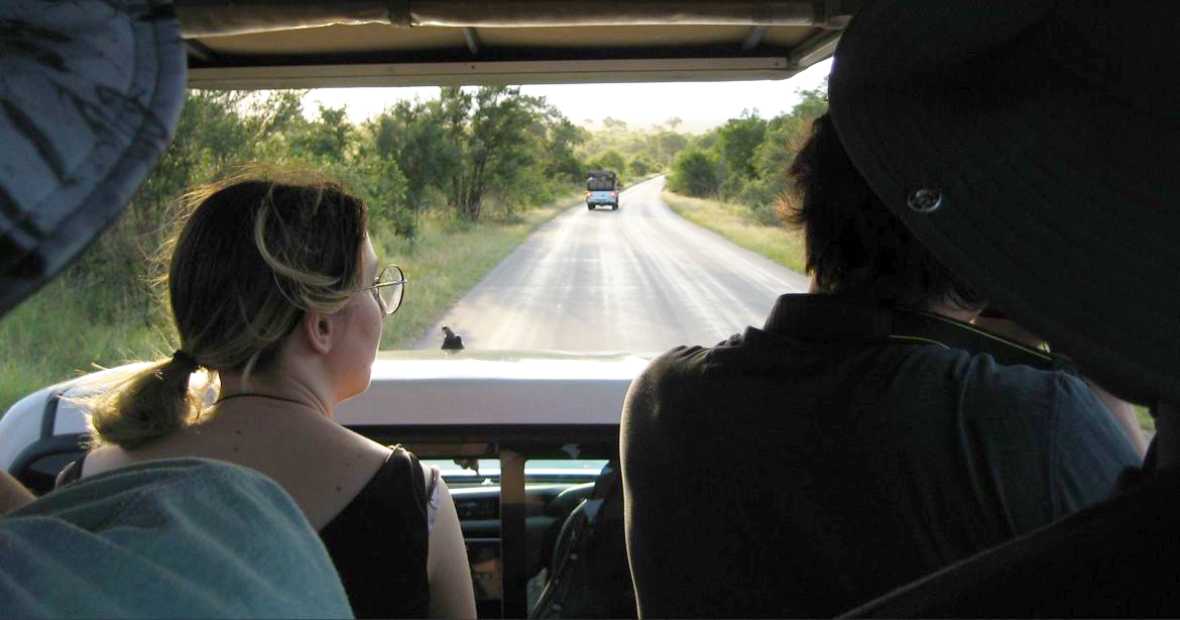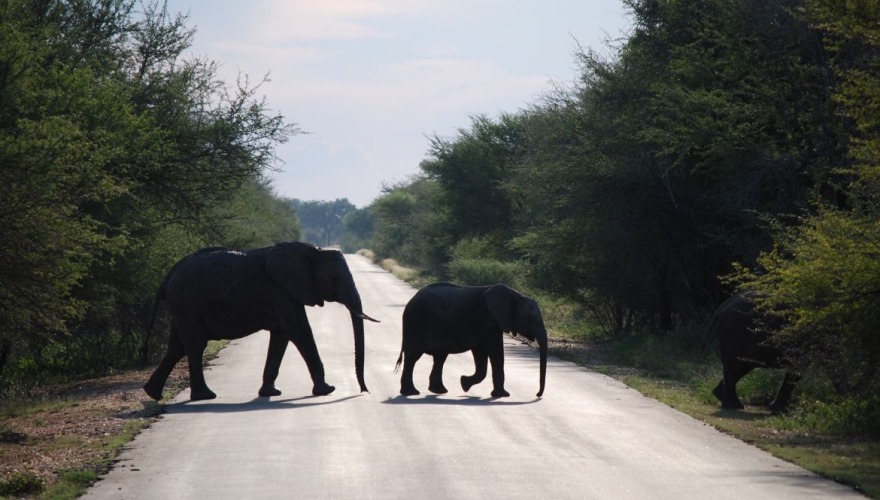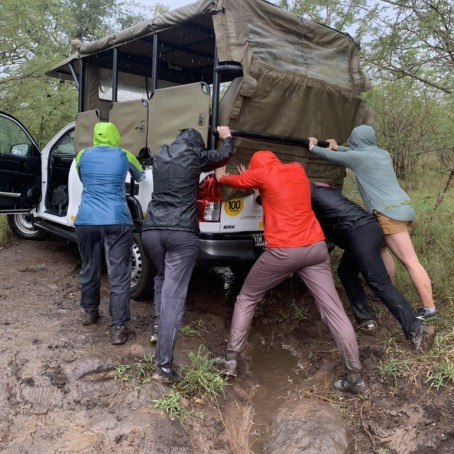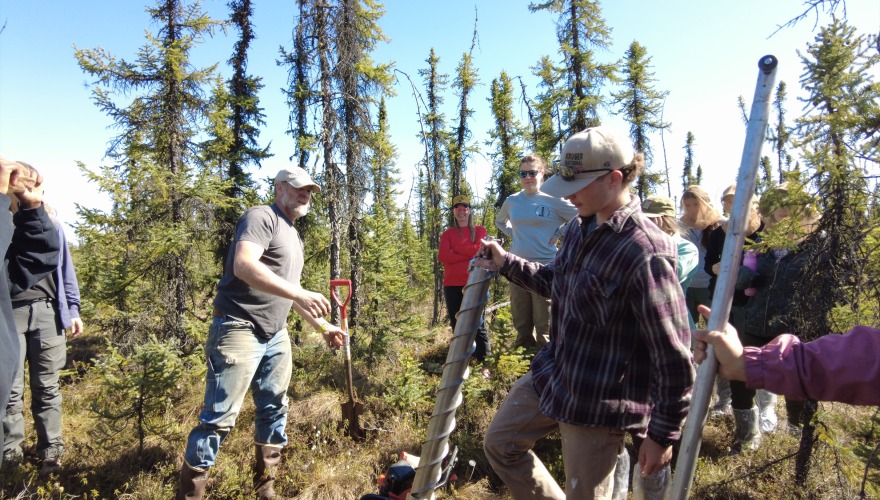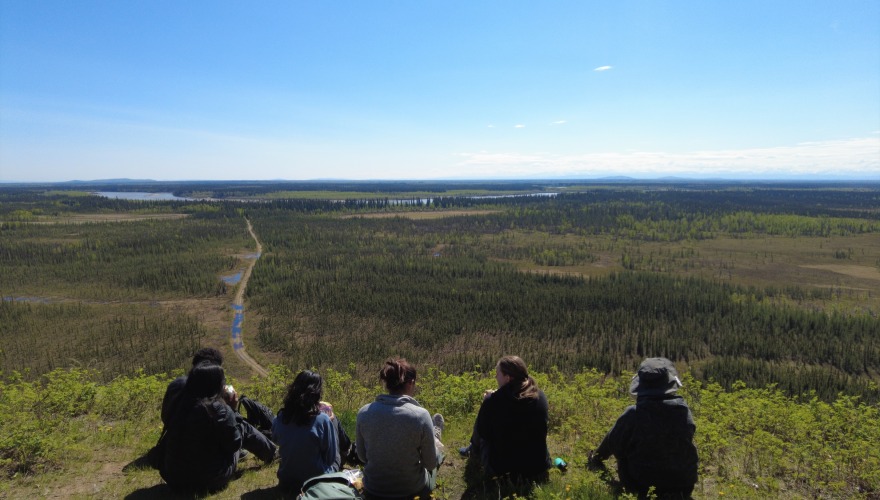From Savanna to Permafrost: GLP Students Track the Origins of Disease
Anika Jane Beamer ’22
Mud caked to their shoes, Molly Ryan ’27, Bea Polo Diz ’27, Meilin Hoshimo ’27, and Erika Jack tramped through the bush in Kruger National Park, South Africa. Despite the torrential rain and thorny undergrowth, spirits were high as they hiked to their field research site. Having arrived in South Africa two days prior, their task for the day was straightforward: set up rodent traps along the border between the national park and the surrounding community. Of course, research in lion country is never simple:
“Nobody is allowed to get out of their cars in Kruger Park without special permission and armed guards,” explains David Campbell, Henry R. Luce Professor of Nations and the Global Environment. “So these students had two armed guards with them any time that they were out in the field.”
Taking Field Work to the Next Level
Over spring break, Campbell, Jack (staff course leader and Grinnell’s Intranet cloud specialist), and Professor of Biology Shannon Hinsa-Leasure traveled to South Africa with the 15 first-year students in their Global Learning Program (GLP) course, Emerging Infectious Diseases. Made possible by gifts to the Institute for Global Engagement (IGE) from Susan McCurry ’71 and the Holden Family Foundation, Grinnell’s Global Learning Program courses tackle interdisciplinary global issues during a semester-long class and three weeks of field-based learning in multiple countries, regions, or ecosystems. “Professors Campbell and Hinsa-Leasure’s course is a stellar example of the types of curricular global learning experiences offered to Grinnellians through the Institute for Global Engagement,” shared Ashley Laux, associate director of Faculty-led Learning Across the Globe (FLAG) at Grinnell.
In South Africa, the Emerging Infectious Disease students worked with professors Liezl Retief and Laurence Kruger at the Organization for Tropical Studies (OTS) to gather data for ongoing disease ecology research in and around Kruger National Park, Africa’s largest wildlife sanctuary.
During their time in Kruger, Grinnell students trekked to research sites at the center and edge of the park to trap rodents, returning early the next morning to comb ectoparasites from the rodents’ skin and fur and to take blood samples. With the parasites they collected and identified, students analyzed the diversity and range of infectious animal diseases in and around the park.
When they weren’t “giving rodents a spa day,” says Hinsa-Leasure, students heard lecturers from local researchers at the Skukuza Science Leadership Initiative (SSLI) and walked through the savanna with scientists during “field lectures.”
“The students got to do real, impactful disease ecology research, and they also got to learn about animal conservation management. They heard from veterinarians both inside and outside the park to really think about disease in both wild and agricultural animals and the passing of diseases across the park boundary,” Hinsa-Leasure explains.
‘Real Adventure’
This is the second GLP course that Hinsa-Leasure and Campbell have taken to Kruger. It’s the product of extensive planning and a burgeoning partnership with OTS and SSLI.
“The idea for this class was to examine the intersection of humans, animals, and the environment, and how that interaction shapes the movement of diseases,” explains Hinsa-Leasure. “Kruger National Park is an ideal location for that exploration. It is right on the border between a growing human population and a very native environment.”
Not only is Kruger at the crux of questions about zoonotic disease, but it is also an ecosystem wildly different than what Grinnellians are familiar with. “For students, this research is a real adventure,” says Campbell. “We were totally privileged to be able to get out on our two feet in this park. It’s just something that almost nobody’s allowed to do.”
‘A Mind Blowing Experience’
From run-ins with wildlife while collecting samples, to Campbell’s attempts to speak “Crocodile Esperanto,” Molly Ryan ’27 documented much of her adventure in a travel journal.
On their first night, the class went for a sunset game drive to witness the incredible wildlife that call Kruger home. “Such a mind blowing experience,” wrote Ryan. “I love it here! And we’re just getting started.”
Many nights during their stay at Kruger would end the same way — with a sunset safari. “The night drives are really special,” Ryan later wrote. “Tonight, we saw hippos, elephants, a leopard, water buffalo, and a lioness! Also, zebras, monkeys, baboons, impala, giraffes, warthogs, chameleon, kudu, blue wildebeests, and a crocodile!”
The South Africa adventure was made more profound by the resilience and enthusiasm of students like Ryan, says Campbell. “We brought 15 amazing students out there. We got rained on many days in the field, I’m talking drenched, and they just kept on working. They thrived in that environment.”
In fact, for Ryan, some of the more trying moments ended up being trip highlights. On their second day in the field, her research team’s truck got stuck in muddy roads from pouring rain. “Our research leader handled the roads like a fiend, but there was only so much we could do in the torrential downpour, and the truck got stuck.” wrote Ryan. "After several MacGyvered attempts to extract the vehicle, a Boomslang encounter, a walk alongside native cattle, and a successful setup of the second site, help arrived. We got ice cream and arrived home hours after the other groups, feeling much closer than we had left. What an amazing experience!”
Looking to the Future
It’s important to Campbell and Hinsa-Leasure that the partnership between Grinnell, OTS, and SSLI is a collaborative one. “Our hosts in Kruger have been incredibly welcoming to us, and so we want to make sure we are doing good, helpful research while we are there,” says Hinsa-Leasure. The data gathered by Grinnell students during their trip join an expanding dataset overseen by Kruger’s new disease ecologist.
In years to come, Hinsa-Leasure hopes to broaden the class to include both Grinnell students and South African students. If permanent funding becomes available, she plans to host South African students at Grinnell and introduce them to related research with emerging infectious disease among Iowa’s livestock population.
South Africa isn’t the only destination for the Emerging Infectious Disease class this spring. After finals, they travelled to Fairbanks, Alaska, where they worked with Grinnell alum Devin Drown ’97 and Mary Beth Leigh to study disease spread by sequencing the genomes — some as old as 4,000 years — that are found in the frozen permafrost.
“Alaska is a very different environment in which to think about emerging diseases,” says Hinsa-Leasure. “In Alaska, broadly, there hasn’t been that much animal disease because so few infectious agents can withstand the cold winters. But as climate change continues to warm things up, we might see a lot more diseases being brought into the area and possibly coming from the melting permafrost,” she explains. While in Alaska, the class also studied nature journaling with a local artist at long-term research site, Bonanza Creek.
Their travels and field work this semester have been eye-opening for Campbell and Hinsa-Leasure’s students. “Some students came into this class interested in disease and thinking they would go to medical school. Now that they’ve been opened to a much wider realm of study in terms of disease and health, many of them have a very different idea of what is possible in their future,” explains Hinsa-Leasure.
“Public health is such a vastly diverse and interesting field,” Campbell says. “And this class is a truly remarkable way to demonstrate that.”

